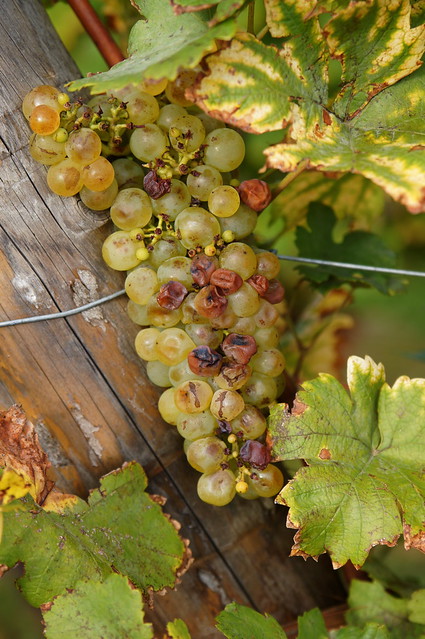cépage Noun, masculine
(a) (type of) vine, =grape variety; il connaît tous les ~s he knows all the different types of wine
I first heard the term cépage as part of a particular wine release. The translation the friendly winery droid provided was "family," which as a romantic I prefer over "grape variety." I think it makes the concept easier to understand when you try to wrap your head around how the syrah in your glass from the Wahluke Slope of Washington is related to the shiraz of Australia, or the syrahs of the Rhone. I've been rather fond of late of getting to know these families in more detail, by chasing them through all of their iterations, geographies and terroirs. My goal is to find those threads that tie them together to their "relations" - what are the things that you can still identify no matter where it comes from, no matter what winemaking techniques are applied?

When I first tried a merlot from Ticino in the Italian-speaking part of Switzerland, I was amazed. It tasted...Italian. It tasted lean, and mean, and altogether more complex than the lush, zaftig merlots I had known before. It tasted like merlot, though, for all of its differences with my previous acquaintances. There was something there that was part of its character, that identified it as a part of its family. Granted, I had experienced merlot in the vineyard, at crush, and in the fermenter, but I think I would have been able to recognize Signore Merlot from Ticino without that level of experience.

This past summer, my family (my spouse) and I chased rieslings from middle Alsace up into the Mosel valley. Riesling was one of my first loves. My father brought a love of the grape back from his postings in Germany post-war, and so it was a family friend from early on. When I started to drink more wine, and then learn about wine, riesling was my first love. Simple and available rieslings, then discovering "mit pradikat" enchantresses, then spatlese and auslese...Then came respectable "American girl" rieslings from the US from places like Washington state and Long Island. Then...then I discovered Alsace. It's not that I would say Alsatian rieslings are better than any other rieslings, it's just that they are soooo good. All of the above rieslings are different, they all have their excellent qualities and characteristics, but all of them are different enough to pair with different foods and be appropriate for different occasions. As we drove up the Rhine valley, and hopped over to the Mosel, it seemed that every 50 kilometers or so the wine had become something subtly different. What a family...
Why not get to know your wine's family better? It's high time you were introduced. Take the wines you like, the wines you are drinking, and identify what family they come from - cabernet sauvignon, pinot noir, temperanillo, sangiovese - and see if you can find other branches of the family to get to know. Maybe you'll find the mischievous cousin, the overbearing uncle, the comedian father, the flirty aunt. Families are amazing, don't ya think?

 Grabbed a bottle a little too quickly form the cellar, not realizing what a gem I'd taken from the treasure trove. Decided on something else with dinner, we kept this little beauty aside until we were all done packing for a trip to Paris. Sat down, poured a glass, and were transported away entirely. The vendage tardive is a late harvest, and this particular grape, from this particular winemaker in Alsace, is absolutely transcendant. Yes, it's powerfully sweet, but let it rest for an extra second on your palette and an amazing pageantry steps out from behind the honey and raisin flavors. The age becomes this complex tapestry with visions of the vines on their Rhine valley hillsides basking in the sun in the summer of their lives, and then shivering slightly in the cold of the autumn, passing through their entire life well into old age before they join their ancestors in the winery. Gewurtztraminer is not to be missed, and you would be well advised to find some room for it next to its better known riesling cousins. As a normal vendage it's fantastic with Asian foods in particular, but as a vendage tardive it is outstanding on its own as a dessert treat. It would also be lovely with a nice foie gras, or maybe a slightly sweet honey-lavender goat cheese tart.
Grabbed a bottle a little too quickly form the cellar, not realizing what a gem I'd taken from the treasure trove. Decided on something else with dinner, we kept this little beauty aside until we were all done packing for a trip to Paris. Sat down, poured a glass, and were transported away entirely. The vendage tardive is a late harvest, and this particular grape, from this particular winemaker in Alsace, is absolutely transcendant. Yes, it's powerfully sweet, but let it rest for an extra second on your palette and an amazing pageantry steps out from behind the honey and raisin flavors. The age becomes this complex tapestry with visions of the vines on their Rhine valley hillsides basking in the sun in the summer of their lives, and then shivering slightly in the cold of the autumn, passing through their entire life well into old age before they join their ancestors in the winery. Gewurtztraminer is not to be missed, and you would be well advised to find some room for it next to its better known riesling cousins. As a normal vendage it's fantastic with Asian foods in particular, but as a vendage tardive it is outstanding on its own as a dessert treat. It would also be lovely with a nice foie gras, or maybe a slightly sweet honey-lavender goat cheese tart.


